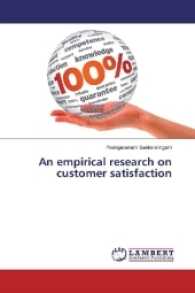- ホーム
- > 洋書
- > 英文書
- > Science / Mathematics
Full Description
Wastewater treatment is an energy intensive process that removes contaminants and protects the environment. While some wastewater treatment plants (WWTPs) recover a small portion of their energy demand through sludge handling processes, most of the useful energy available from wastewater remains unrecovered. Efforts are underway to harness energy from wastewater by developing microbial fuel cells (MiFCs) that generate electricity.
Key challenges to the development of microbial fuel cells include inefficiencies inherent in recovering energy from microbial metabolism (particularly carbon metabolism) and ineffective electron transfer processes between the bacteria and the anode. We explored the prospects for constructing microaerobic nitrifying MiFCs which could exhibit key advantages over carbon-based metabolism in particular applications (e.g., potential use in ammonia-rich recycle streams). In addition, we evaluated nanostructure-enhanced anodes which have the potential to facilitate more efficient electron transfer for MiFCs because carbon nanostructures, such as nanofibers, possess outstanding conducting properties and increase the available surface area for cellular attachment.
In the initial phase of this project, we investigated the performance of a novel nitrifying MiFC that contains a nanostructure-enhanced anode and that demonstrated power generation during preliminary batch testing. Subsequent batch runs were performed with pure cultures of Nitrosomonas europaea which demonstrated very low power generation. After validating our fuel cell hardware using abiotic experiments, we proceeded to test the MiFC using a mixed culture from a local wastewater treatment plant, which was enriched for nitrifying bacteria. Again, the power generation was very low though noticeably higher on the nanostructured anodes.
After establishing and monitoring the growth of another enriched nitrifying culture, we repeated the experiment a third time, again observing very low power generation. In the absence of appreciable and repeatable power production from pure and mixed nitrifying cultures, we focused on the second major objective of the work which was the fabrication and characterization of carbon nanostructured anodes. The second research objective evaluated whether or not addition of carbon nanostructures to stainless steel anodes in anaerobic microbial fuel cells enhanced electricity generation.
The results from the studies focused on this element were very promising and demonstrated that CNS-coated anodes produced up to two orders of magnitude more power in anaerobic microbial fuel cells than in MiFCs with uncoated stainless steel anodes. The largest power density achieved in this study was 506 mW m-2, and the average maximum power density of the CNS-enhanced MiFCs using anaerobic sludge was 300 mW m-2. In comparison, the average maximum power density of the MiFCs with uncoated anodes in the same experiments was only 13.7 mW m-2, an almost 22-fold reduction. Electron microscopy showed that microorganisms were affiliated with the CNS-coated anodes to a much greater degree than the noncoated anodes. Sodium azide inhibition studies showed that active microorganisms were required to achieve enhanced power generation.
The current was reduced significantly in MiFCs receiving the inhibitor compared to MiFCs that did not receive the inhibitor. The nature of the microbial-nanostructure relationship that caused enhanced current was not determined during this study but deserves further evaluation. These results are promising and suggest that CNS-enhanced anodes, when coupled with more efficient MiFC designs than were used in this research, may enhance the possibility that MiFC technologies can move to commercial application.








